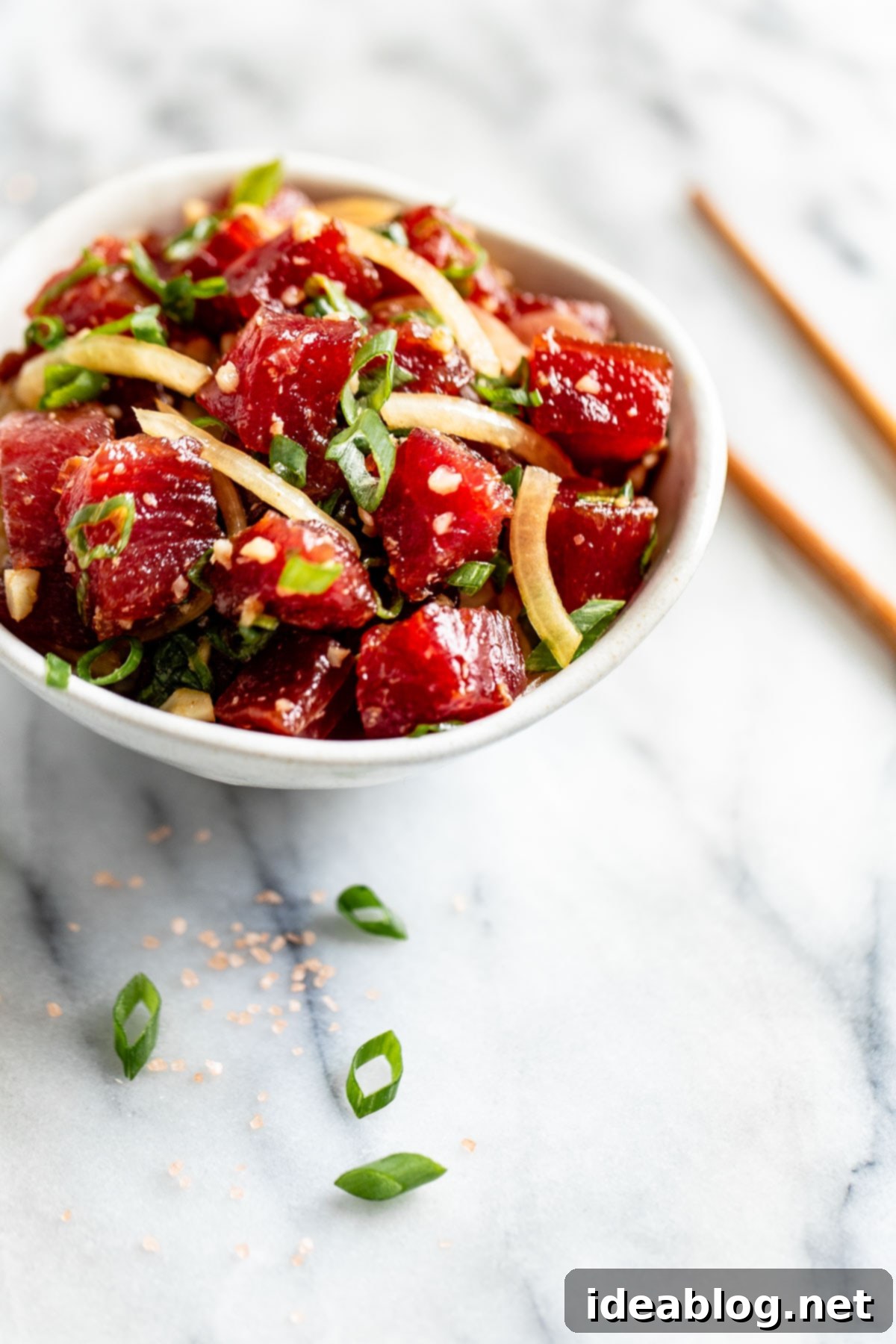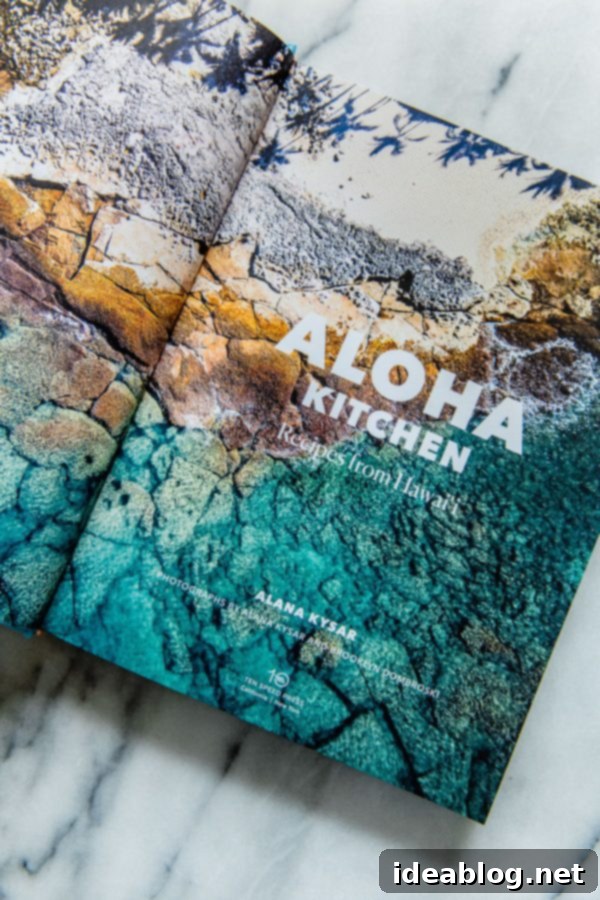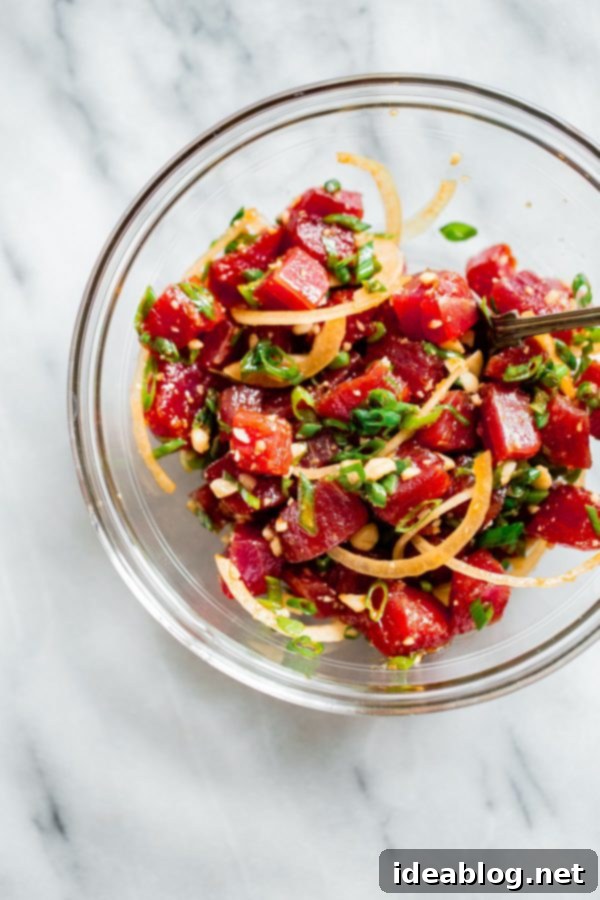Authentic Shoyu Ahi Poke Bowl Recipe: A Taste of Traditional Hawaiian Cuisine
Experience the vibrant flavors of Hawaii with this traditional Shoyu Ahi Poke Bowl recipe. Crafted with the freshest sashimi-grade ahi tuna, sweet Maui onions, classic soy sauce (shoyu), aromatic sesame oil, crunchy macadamia nuts, and fresh scallions, this dish is a culinary journey to the islands. Simple to prepare yet incredibly satisfying, it’s a perfect escape for your palate.
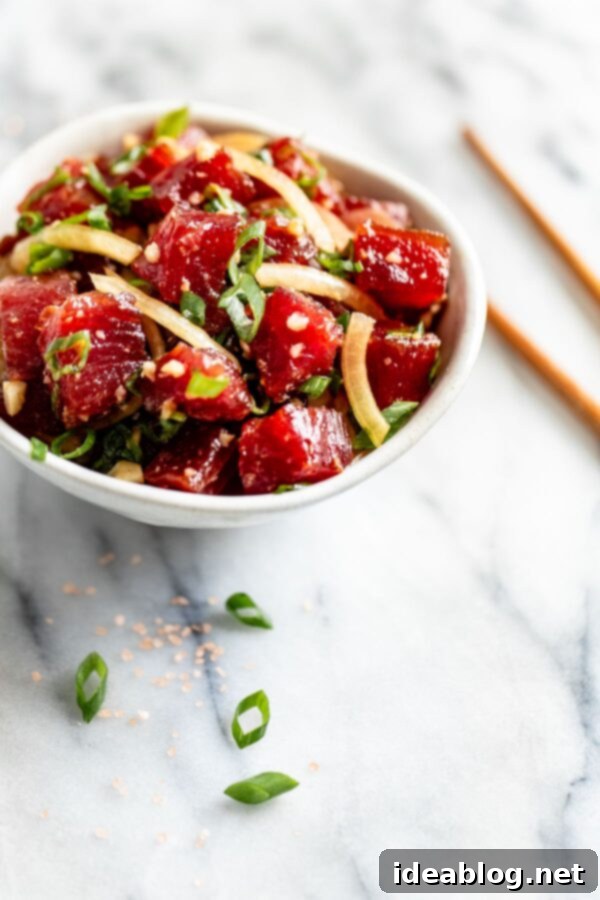
As the days grow longer and the sun shines brighter, my kitchen officially shifts into summer mode. This means a craving for meals that are not only bursting with flavor and deeply satisfying but also remarkably quick to prepare. This traditional Shoyu Ahi Poke recipe effortlessly checks all those boxes and more. It’s a dish that embodies simplicity, delivers an irresistible crave-worthiness, and achieves an incredible balance of fresh flavors that instantly transports you to a Hawaiian beach, even if you’re thousands of miles away.
For any enthusiast of raw seafood, particularly fresh tuna, poke holds a truly special place. And, I can confidently say that this specific preparation stands out as the finest ahi poke bowl I’ve had the pleasure of enjoying to date. If you’re already a dedicated poke aficionado or simply someone who appreciates the delicate taste and texture of raw tuna, you are absolutely going to adore this recipe. It’s a refreshing, healthy, and genuinely authentic culinary experience that brings the spirit of Hawaii right to your table.
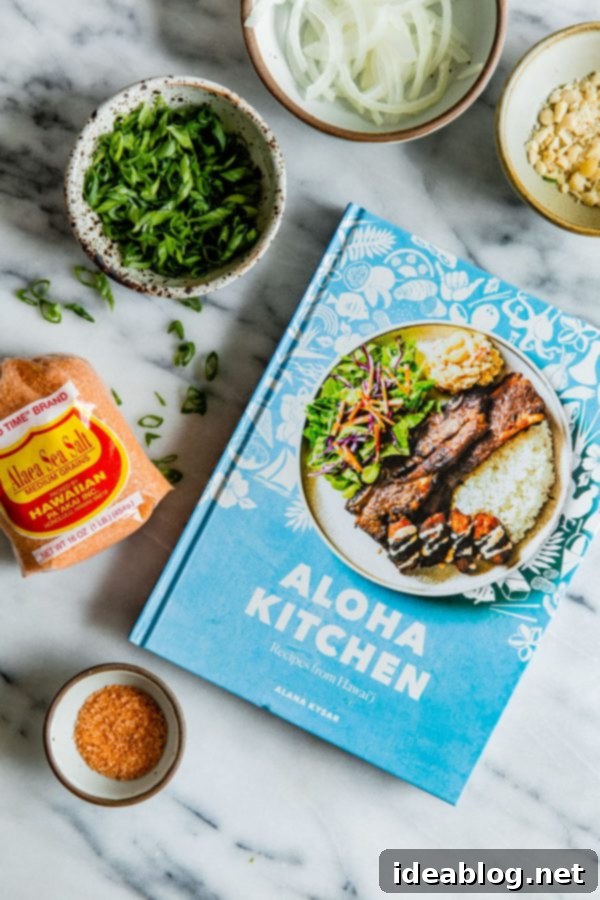
Discovering Hawaiian Flavors with Aloha Kitchen
This exquisite and authentic ahi poke bowl recipe is proudly sourced from my talented friend Alana Kysar’s magnificent cookbook, Aloha Kitchen [affiliate link]. This book is far more than just a collection of recipes; it’s a vibrant and heartfelt celebration of local Hawaiian cuisine, deeply intertwined with the rich culture and history of the islands. Growing up on the beautiful island of Maui, Alana possesses an unparalleled understanding and appreciation for Hawaiian food. She masterfully weaves together captivating stories of Hawaiian history, revealing how its unique food culture has been shaped by diverse influences and traditions over generations. This narrative depth is coupled with a treasure trove of over 85 carefully curated recipes for genuine local Hawaiian dishes.
Within the pages of Aloha Kitchen, you’ll embark on a culinary adventure, discovering an incredible array of dishes that reflect Hawaii’s diverse gastronomic landscape. From savory lumpia and the iconic soy-glazed Spam Musubi to comforting Shoyu Chicken, the hearty Loco Moco, the sweet and delicate Haupia Pie, and delectable Guava Cake, Alana covers it all. The book is not only a feast for the palate but also a visual delight. Its photography, thoughtful layout, and elegant design are truly stunning, making it a joy to browse and cook from. My own experience with local Hawaiian food was quite limited before encountering this book, having only visited Hawaii once many years ago. It was precisely this unfamiliarity that drew me so powerfully into its pages. The best cookbooks have a magical ability to allow you to experience a culture and a place through its food, and Alana accomplishes this with remarkable success in Aloha Kitchen. Fair warning, though: after spending time with this book, you’ll undoubtedly find yourself wanting to book a vacation to Hawaii immediately!
What Exactly is Poke? A Deep Dive into this Hawaiian Delicacy
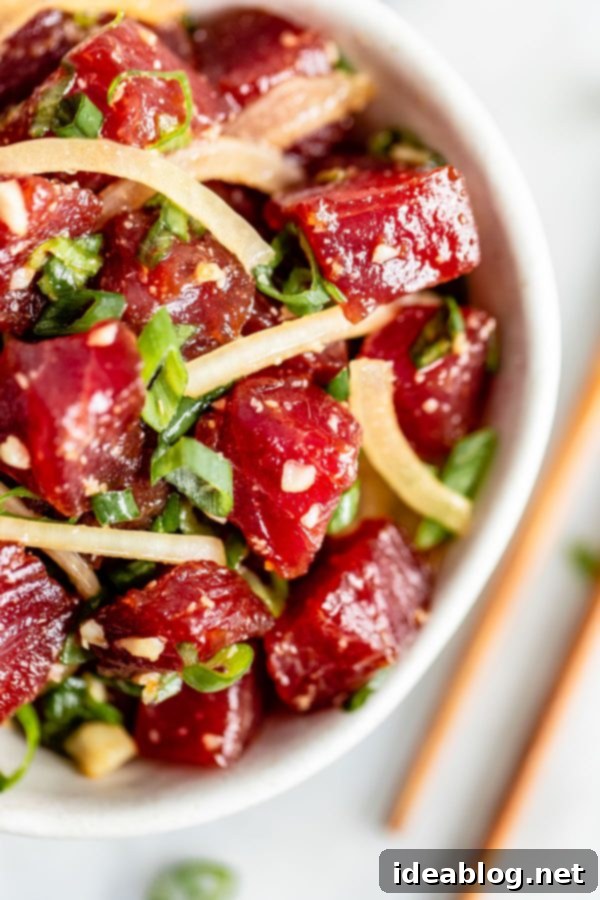
For those unfamiliar with this captivating dish, poke (pronounced PO-kay, rhyming with “okay”) is a fundamental Hawaiian delicacy, traditionally served as either an appetizer or a main course. At its heart, poke is typically made with raw fish, and its name itself gives a clue to its preparation: “poke” translates to ‘to slice or cut’ or ‘section’ in Hawaiian. This reflects the method of cubing the fish into bite-sized pieces, which are then seasoned and served.
While modern poke has seen countless variations emerge, incorporating everything from creamy sauces to diverse toppings, I’ve always found myself gravitating towards simpler, more traditional preparations like the one featured here. This classic style focuses on the pristine quality of the fish and the delicate balance of its marinade, often made without mayonnaise or other heavy additions that can obscure the natural flavors. Traditional poke, particularly the popular “shoyu ahi” variety, typically features succulent cubes of ahi (yellowfin) tuna. These vibrant pieces of fish are lightly tossed in a foundational dressing of savory soy sauce (known as shoyu in Hawaii) and fragrant sesame oil. It’s then thoughtfully garnished with crisp raw onion, bright green onions, and the delightful crunch of chopped macadamia nuts. The result is a dish that is refreshing, flavorful, and a true testament to the elegance of Hawaiian culinary traditions.
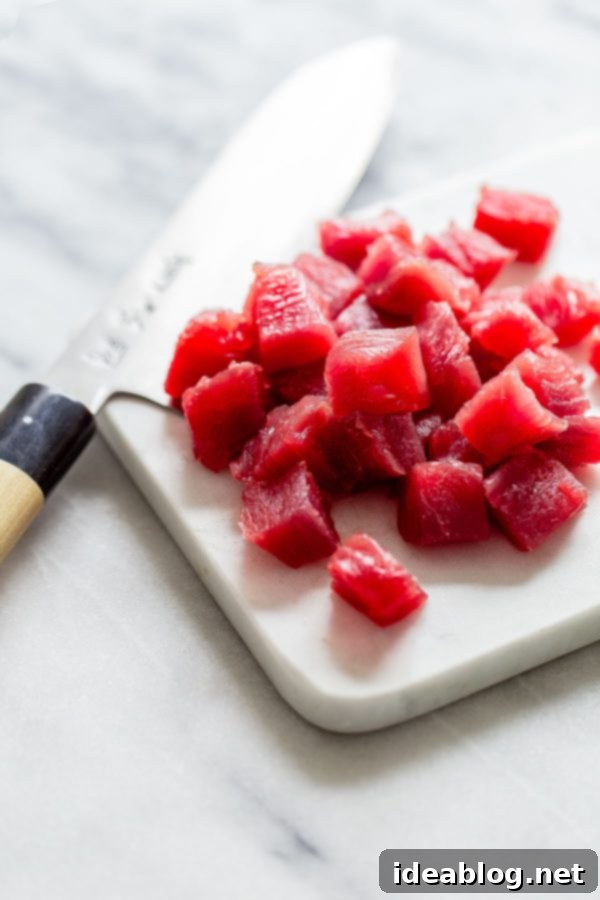
Essential Ingredients for Authentic Shoyu Ahi Poke
If you’re new to preparing raw fish dishes at home, or perhaps a little nervous, rest assured that with the right ingredients and a few key tips, you can create a spectacular poke bowl. Here’s a detailed look at the essential components for this Shoyu Ahi Poke:
- Ahi or Yellowfin Tuna: The cornerstone of any great poke, the quality of your tuna is paramount since it will be consumed raw. It is critically important to source the freshest, highest-quality ahi or yellowfin tuna available. Always seek out a reputable seafood market or fishmonger you trust. Often, tuna suitable for raw consumption is labeled as “sashimi-grade” or “sushi-grade.” While these terms aren’t federally regulated, they generally indicate that the fish has been handled with extra care and is intended for raw preparations. Don’t hesitate to inform your fishmonger that you plan to make poke; they can usually guide you to the best possible cut. If you can’t guarantee top quality, it’s safer to skip this dish entirely.
- Soy Sauce (Shoyu): This recipe specifically calls for regular, full-sodium soy sauce. Please resist the temptation to substitute with low-sodium varieties or other soy sauce alternatives, as they will alter the intended flavor profile. Shoyu, made from fermented soybeans, is a powerhouse of umami, providing the deep, savory foundation that is absolutely vital to the overall taste and authenticity of this Hawaiian dish.
- Sesame Oil: In recipes with a limited number of ingredients, the quality of each component shines through. The same principle applies to sesame oil. Over time, sesame oil can become rancid, so if you have a bottle that has been sitting in your pantry or fridge for many months, it’s wise to check its freshness or replace it. I personally use and highly recommend Kadoya brand [affiliate link] for its consistently great, pure sesame flavor that truly enhances the poke.
- Hawaiian Salt (‘Alaea): This traditional recipe specifies Hawaiian ‘alaea sea salt. This unrefined sea salt is uniquely blended with volcanic red clay (alaea), which imparts a distinct flavor and a beautiful reddish hue. It’s frequently used in authentic Hawaiian cuisine. If ‘alaea salt is difficult to find or if you prefer not to purchase a specialized ingredient, Alana suggests a coarse pink Himalayan salt as a suitable substitute. You can conveniently purchase Hawaiian ‘alaea sea salt online through Amazon [affiliate link].
- Maui or Yellow Onion: For the most authentic flavor, traditional poke recipes call for raw, thinly sliced Maui onion. Known for its sweetness and mild flavor, Maui onion complements the tuna perfectly. However, if Maui onions are unavailable, a good quality yellow onion can be used as a readily accessible and acceptable substitute.
- Green Onions (Scallions): You’ll need a generous amount of freshly chopped green onions for this recipe. Be sure to use only the bright green parts, as they provide a fresh, pungent bite and vibrant color that enhances both the flavor and visual appeal of the poke.
- Gochugaru (Korean Red Chili Flake): This recipe includes a small quantity (just ⅛ teaspoon) of gochugaru, a Korean red chili powder. It adds a subtle hint of heat and a beautiful color without overpowering the other delicate flavors. If gochugaru is not available, you can substitute it with Aleppo pepper for a similar mild spice, or finely crushed red pepper flakes for a slightly more intense heat.
- Macadamia Nuts: Toasted and finely chopped macadamia nuts are a crucial addition, providing a wonderful textural contrast and a rich, buttery flavor that is distinctly Hawaiian. Don’t skip these; they add a delightful crunch and depth to each bite.
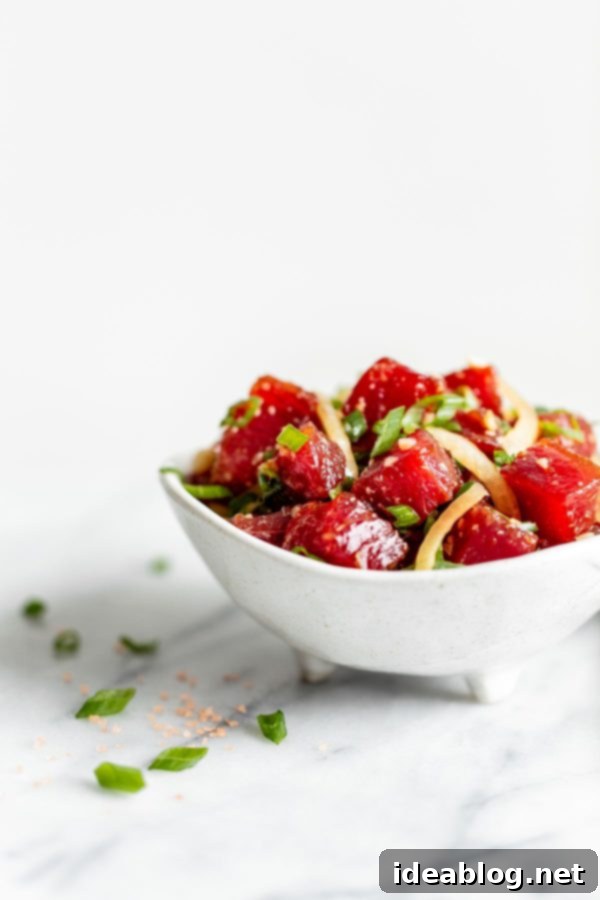
Simple Steps to Create Perfect Ahi Poke at Home
Given that this delectable dish features raw tuna, it is absolutely essential to prepare and serve it just before consumption. This ensures the optimal freshness, texture, and food safety. Planning on leftovers is generally not recommended with raw fish dishes like poke. Furthermore, ingredients such as the delicate raw onion slices, the crunchy chopped macadamia nuts, and the vibrant scallions will maintain their best possible texture and flavor when freshly prepared and combined.
For this authentic preparation, you’ll want to carefully slice your sashimi-grade tuna into uniform 1-inch cubes. A key tip for cutting tuna (and other meats) is to always slice against the grain. This technique is vital as it breaks down the muscle fibers, yielding the most tender texture and significantly improving the overall eating experience of the poke. Once your tuna is perfectly cubed and chilled, gently combine all the ingredients in a bowl. Use your hands or a spoon to carefully toss them together, ensuring every piece of tuna is evenly coated with the flavorful shoyu-sesame dressing and interspersed with the fresh onions and crunchy nuts. Adjust the seasoning to your liking, adding a touch more soy sauce or salt if desired.
While this vibrant poke is utterly delicious enjoyed on its own as a light and refreshing meal or appetizer, it truly shines when served alongside perfectly steamed rice. I personally love to use a slightly sticky sushi rice, as its texture complements the poke beautifully. Just remember to ensure your rice is not hot when serving, as this can affect the temperature and delicate texture of the raw tuna. Room temperature or slightly warm rice is ideal for a harmonious culinary experience. This simple yet elegant dish is an effortless way to bring the authentic taste of Hawaii into your home.
If you savor this incredible recipe as much as my family and I did, I wholeheartedly encourage you to explore more of the beautiful Hawaiian culinary traditions found in Aloha Kitchen by Alana Kysar. It’s a cookbook that keeps on giving!
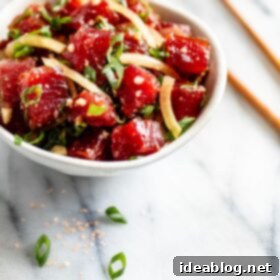
Traditional Shoyu Ahi Poke Recipe
Pin
Review
SaveSaved!
Ingredients
- 1 lb fresh sashimi-grade ahi tuna steak chilled and cut into 1-inch cubes*
- 1½ tablespoons soy sauce (shoyu) plus more to taste, ideally regular sodium for authentic flavor
- 1 tablespoon sesame oil use a high-quality, fresh oil
- ¾ teaspoon Hawaiian salt (‘alaea) plus more to taste, or coarse pink Himalayan salt as a substitute
- ¼ cup thinly sliced Maui or yellow onion Maui onion preferred for sweetness
- ½ cup chopped green onions (scallions) green parts only, for freshness and color
- ⅛ teaspoon gochugaru (Korean red chili powder) optional, for a touch of heat; substitute with Aleppo pepper or fine red pepper flakes
- 1 tablespoon finely chopped toasted macadamia nuts for essential crunch and buttery flavor
- 2 cups steamed short-grain rice for serving, preferably at room temperature
Instructions
-
In a large, non-reactive bowl, gently combine the chilled, 1-inch cubed ahi tuna with the soy sauce, sesame oil, Hawaiian salt (or substitute), thinly sliced Maui (or yellow) onion, chopped green onions, gochugaru (if using), and finely chopped toasted macadamia nuts. Using clean hands or a large spoon, carefully toss all the ingredients together until the tuna is evenly coated. Taste and adjust the seasoning as needed, adding a little more soy sauce or salt if desired to enhance the flavors.
-
Serve your freshly prepared Shoyu Ahi Poke immediately. It can be enjoyed on its own as a vibrant appetizer or a light meal, or traditionally served over a bed of warm (not hot) steamed short-grain rice for a complete and satisfying Hawaiian poke bowl experience. Enjoy this taste of the islands without delay!
Tips for Success and Variations:
- For an added layer of complexity and texture, consider lightly toasting the macadamia nuts yourself just before chopping. This brings out their natural oils and deepens their flavor.
- To ensure optimal freshness and food safety, always keep your tuna thoroughly chilled until just before mixing. Once prepared, poke should be consumed promptly and not stored for later.
- While this recipe champions traditional flavors, feel free to experiment with a very small amount of finely minced fresh ginger or a squeeze of fresh lime juice for a slight twist, if desired, though these are not traditionally part of shoyu ahi poke.
- If you don’t wish to purchase Hawaiian ‘alaea salt specifically for this recipe, a high-quality coarse sea salt, such as Pink Himalayan, is a good alternative. When substituting salts, start with a slightly smaller portion than specified for ‘alaea salt and always season to taste, as different salts have varying densities and sodium levels.
- The gochugaru adds a subtle, pleasant heat. If you prefer more spice, you can slightly increase the amount or add a tiny pinch of cayenne pepper, being careful not to overpower the delicate tuna flavor.
Reprinted with permission from Aloha Kitchen by Alana Kysar (Ten Speed Press, March 2019).
